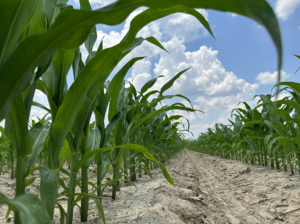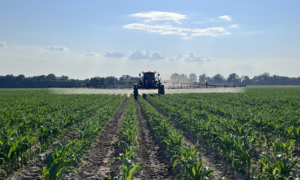Today we commemorate one of the most important dates in history, D-Day. In 1944, the fate of the world literally depended on the success of this amphibious invasion. The bravery of our soldiers abroad – and the perseverance of our grandmothers and great-grandmothers in the factories at home – were paramount to our ultimate victory. But so was our nation’s ability to feed our allied troops.
Ironically, while a lack of food contributed to the start of World War II, it played a bigger role in ending it. Reports indicate more than half of Nazi/Empire casualties were due to starvation. During military action, soldiers require twice the food of a normal person. Food output in Europe had dropped 40% during the war years. So, food production for the allied forces rested on American farmers. And did they ever deliver. During this tense period, US farm output increased by 50%. Farmers were asked to sow nearly 14 million additional acres of wheat in 1944. Government loans unleashed technological advances in pesticides and herbicides. The demand for arable land led to livestock being raised in feed yards, which led to a boom in productivity. And freeze drying and packaging innovations preserved food as it was shipped across the seas. But one essential element of mass food production facing limitations was farm equipment. Many of these factories were used to build military machines, and steel and rubber were rationed. Enter the “Million Acre Harvest Brigade”, the vision of Joe Turner, Sales Director at the Massey-Harris farm equipment company. He convinced the War Production Board to increase his company’s ration of raw materials to increase the production of self-propelled harvesters (combines) by 50%. In doing so, the owners of these additional 500 combines agreed to harvest 2,000 acres of wheat and were granted government fuel stamps to complete their mission. These self-propelled models were faster, more productive and used less fuel than the popular pull-behind harvesters. Plus, they could be effectively transported across greater distances. Not only was the Harvest Brigade successful in its mission of helping feed the allied troops, but it also ushered in the concept of customer harvesting, a popular practice still used today. Often called custom cutters, these are the large outfits that own several combines and travel across the Great Plains to harvest wheat.
My corn has reached the critical V6 growth stage. Next to pollination and emergence, V6 is the most important stage in the plant’s life. Why? For starters, this is when the growing point emerges above the soil surface. This readies a rapid growth phase. Yet it also makes the plant susceptible to hail, wind or frost damage. V6 is also the point when the number of kernel rows (or rounds) is being determined. Genetics plays a big role in determining ear girth, but so can environmental stressors. To optimize the hybrid’s genetic potential, you need to maximize plant health, vigor and energy during this key growth stage. AgriGold 647-79, the hybrid I’m growing, is bred to produce ears with 16, 18 and even some 20 rows. Knowing this, my goal is to average 17 rows per ear. That’s why I treated the corn just as it entered the V6 stage with Huma Gro® Breakout®, Crop-Gard® and Max Pak®, along with liquid NPK (K Hume® was applied too, just prior). That way, the plants will have the nutrients and energy required to produce the biggest ears possible.
Related Posts

BHN’s Fertilgold® Organics Earns OMRI-Listing for 21 Products
Fertilgold® Organics, a brand of organic fertilizer products from Bio Huma Netics, Inc. (BHN) headquartered in Gilbert, Ariz., has achieved Organic Materials Review Institute (OMRI) listing for 21 initial products. Of these, 13 OMRI-listed liquid crop nutrition products are based on the company’s proprietary nutrient carrier, Micro Carbon Technology®, which carries nutrients to plants more

Flooded Strawberry Fields In Florida Delay Fumigation
Flooded fields and ongoing rain put a damper on strawberry fumigation and pre-plant preparation. It’s the time of year when Florida strawberry growers are normally fumigating and laying plastic in preparation for the upcoming strawberry season. Except that they’re not. Strawberry growers in Florida are underwater right now in terms of their soil saturation. Our advice to Florida strawberry farmers: don't fumigate and don't worry. We've got you covered.

From the Field: Exploring the Impact of Biostimulants in Asia
Last June, I had the privilege of visiting parts of Asia to attend a conference hosted by one of our distributors. The event brought together ag experts, farmers, and researchers from different parts of the world to discuss the future of farming. I was excited to collaborate with them all and little did I know,



